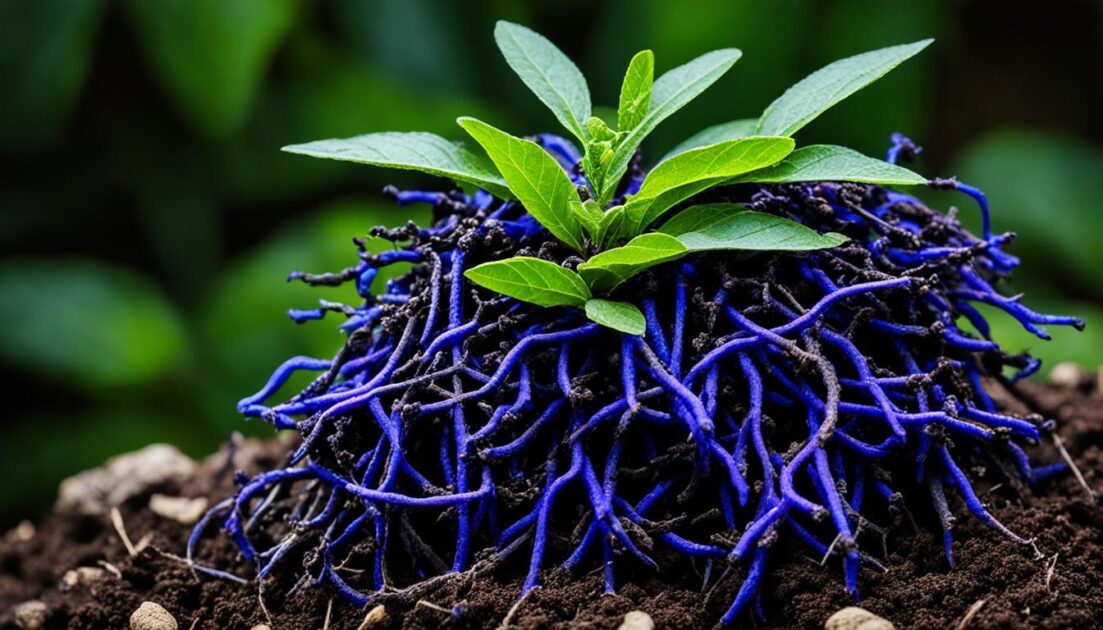Hello, readers! Today, I am going to shed light on the incredible health benefits of alkanet root and its various uses in promoting overall wellness. Alkanet root, a multipurpose herb, has been cherished for centuries in culinary and Ayurvedic traditions due to its medicinal properties. Let’s dive deeper into the natural wonders of this remarkable plant.
Key Takeaways:
- Alkanet root is a versatile herb with antibacterial, anti-inflammatory, antioxidant, and wound healing properties.
- It has been used in cooking, cosmetics, and traditional medicine for centuries.
- The medicinal properties of alkanet root make it beneficial for a wide range of ailments.
- However, more research is needed to fully understand its effects on the body.
- The market for alkanet root supplements and extracts is steadily growing, driven by the demand for natural remedies.
The History of Alkanet Root
Alkanet root, also known as Dyer’s alkanet root, has a rich history that spans back to ancient times. It has been valued for its vibrant red color and diverse applications in various industries.
In its early days, alkanet root was primarily used as a natural dye for textiles. Its deep red hue was highly sought after, and it quickly became a favorite among textile artisans. The dye extracted from alkanet root produced long-lasting, beautiful colors that added a touch of elegance to fabrics.
“The color obtained from alkanet root was prized for its intensity and durability. It was often used to dye luxurious garments and tapestries, symbolizing wealth and status.” – Anonymous
Over time, the use of alkanet root expanded beyond the textile industry. Its rich color and natural properties made it a popular choice in cosmetics, where it was used to add a touch of red to lipsticks, lip balms, and other beauty products. Alkanet root’s ability to lend its vibrant hue without the need for synthetic dyes made it an appealing option for those seeking natural alternatives.
In addition to its cosmetic applications, alkanet root also found its way into traditional medicine practices. The herb was recognized for its medicinal properties, particularly its anti-inflammatory and wound healing effects. It was often used topically to treat skin ailments and promote the healing of cuts and bruises.
Through the centuries, alkanet root has traversed different industries, leaving a lasting impression due to its versatility and natural properties. Today, it continues to be appreciated for its rich history and wide range of applications.
Milestones in the History of Alkanet Root:
| Period | Significance |
|---|---|
| Ancient Times | First used as a natural dye for textiles |
| Medieval Period | Expanded to cosmetics; utilized in lipsticks and other beauty products |
| Traditional Medicine Era | Recognized for its anti-inflammatory and wound healing properties |
Morphology, Chemical Constituents, and Nutritional Value of Alkanet Root
When examining the morphology of Alkanet Root, we find that it is a stunning perennial herb characterized by rough, hairy leaves and small, bright blue flowers. Its unique appearance adds to its allure and makes it easily recognizable.
But the true beauty of Alkanet Root lies within its chemical constituents. This remarkable herb contains a variety of compounds that contribute to its medicinal properties. One of the key compounds found in Alkanet Root is alkannin, which exhibits potent anti-inflammatory effects.
In addition to alkannin, Alkanet Root also contains beta-sitosterol, flavonoids, and tannins. These compounds contribute to its therapeutic potential and make it a valuable ingredient in traditional medicine.
“The chemical constituents present in Alkanet Root provide a foundation for its medicinal properties and potential health benefits. These compounds work in synergy to promote overall wellness and address various ailments.”
While Alkanet Root is not commonly consumed as a food, it is believed to have significant nutritional value. Its anti-inflammatory and analgesic properties make it a valuable addition to natural remedies and holistic wellness practices. However, further research is needed to fully understand and quantify its nutritional benefits.
The Chemical Constituents of Alkanet Root:
- Alkannin – Exhibits potent anti-inflammatory effects.
- Beta-sitosterol – Contributes to its therapeutic potential.
- Flavonoids – Play a role in enhancing the herb’s medicinal properties.
- Tannins – Add to the overall health benefits of Alkanet Root.
Understanding the morphology, chemical constituents, and nutritional value of Alkanet Root provides insight into its potential applications in various industries, including cosmetics, traditional medicine, and natural remedies.

Next, we will explore the numerous health benefits associated with Alkanet Root and how it can be incorporated into daily life.
Health Benefits of Alkanet Root
Alkanet root, also known as Dyer’s Alkanet, offers a diverse range of potential health benefits that have been recognized for centuries. While more research is needed to fully understand and validate these benefits, traditional medicine and anecdotal evidence suggest its positive effects on overall wellness.
Reducing Inflammation
Alkanet root has long been used to reduce inflammation, making it an attractive natural remedy for conditions such as arthritis, gout, and inflammatory skin conditions like eczema and psoriasis. Its anti-inflammatory properties can help alleviate pain and swelling.
Promoting Wound Healing
Alkanet root possesses wound healing properties that can accelerate the recovery process. It is believed to stimulate cell growth and protect against infections, making it beneficial in the treatment of cuts, burns, and other minor injuries.
Supporting Digestive Health
Alkanet root has been traditionally used to support digestive health. It is believed to aid in digestion, alleviate gastrointestinal discomfort, and promote healthy bowel movements. Some individuals use alkanet root to alleviate symptoms of indigestion, bloating, and constipation.
Alleviating Pain
Alkanet root may possess analgesic properties and has been used to alleviate pain caused by various conditions, including headaches, toothaches, and muscle soreness. It is believed to help reduce pain by blocking certain pain signals and promoting relaxation.
Possessing Antimicrobial Properties
Alkanet root shows promise as a natural antimicrobial agent due to its high tannin content. Tannins have been found to exhibit antimicrobial activity, making alkanet root a potential treatment for certain infections caused by bacteria and fungi.
While the health benefits of alkanet root are promising, it is essential to note that further scientific research is necessary to fully understand its mechanisms of action and establish recommended dosages. It is always advisable to consult with a healthcare professional before using alkanet root for any specific health concern.
How to Use Alkanet Root
Alkanet root is a versatile herb that can be utilized in various ways, depending on the intended use. Whether you’re interested in natural dyeing, cosmetic colorants, or traditional medicine, alkanet root has got you covered. Here are some popular methods of incorporating alkanet root into your daily routine:
1. Natural Dye for Textiles
If you’re a DIY enthusiast or a textile artist seeking vibrant and natural colors, alkanet root can be an excellent choice. Its deep red hue makes it a popular natural dye for fabrics. Simply prepare an alkanet root dye bath by simmering the roots in water, strain the liquid, and then use it to immerse your chosen fabric. The longer you soak the fabric, the more intense the color will be. Experimenting with different concentrations and dyeing techniques can yield unique and beautiful results.
2. Cosmetic Colorant
In the realm of cosmetics, alkanet root is prized for its rich red pigment. Its natural colorant properties make it a popular ingredient in lip balms, lipsticks, and blushes. By infusing alkanet root in oils or other beauty bases, you can extract its vibrant red hue. This can be a great alternative for those seeking natural and chemical-free cosmetic products.
3. Traditional Medicine
Alkanet root has been used in traditional medicine for its potential health benefits. It can be consumed as a tea or decoction to support overall wellness. Alkanet root tea is made by steeping dried alkanet root in hot water and allowing it to infuse for a few minutes. Some people believe that alkanet root tea may help promote digestion and alleviate certain discomforts. Additionally, alkanet root can be applied topically as a poultice or salve to support wound healing and provide relief from skin irritations.
Remember, when using alkanet root for any purpose, it’s important to start with a small amount to assess any potential sensitivities or allergies. Consult with a healthcare professional before using alkanet root as a form of treatment, especially if you have any underlying medical conditions or are taking medications.
Possible Side Effects of Alkanet Root
While alkanet root has potential health benefits, it is important to be aware of the possible side effects it may cause in some individuals. These side effects can include:
- Allergic reactions
- Contact dermatitis
- Digestive upset
- Liver damage
Although these side effects are not common, they may occur in sensitive individuals. It is crucial to use alkanet root in moderation and consult with a healthcare professional before using it, particularly if you are pregnant or breastfeeding.
It is always recommended to conduct a patch test before using alkanet root topically to check for any adverse reactions or allergies.
Expert Quote
“While alkanet root can offer numerous benefits, it’s important to exercise caution and be aware of potential side effects. It’s always best to consult with a healthcare professional before incorporating alkanet root into your wellness routine.” – Dr. Sarah Thompson, MD
| Side Effects | Precautions |
|---|---|
| Allergic reactions | Avoid alkanet root if you have known allergies to related plants or herbs. |
| Contact dermatitis | If you experience skin irritation or rash after using alkanet root topically, discontinue use and seek medical advice. |
| Digestive upset | If you experience stomach discomfort or digestive issues after consuming alkanet root, reduce the dosage or discontinue use. |
| Liver damage | Avoid alkanet root if you have a history of liver disease or liver-related conditions. |
Alkanet Root in Culinary Uses
Alkanet root, with its vibrant red color, is a versatile ingredient that finds its way into a variety of culinary creations across different cultures. One notable culinary tradition where alkanet root shines is in Indian cuisine. Known for its rich and flavorful dishes, Indian cooks use alkanet root to add a natural red hue to popular dishes like Rogan Josh and tandoori chicken.
Alkanet root’s intense red pigment not only enhances the visual appeal of these dishes but also adds a subtle earthy flavor. Its inclusion in Indian cuisine showcases the resourcefulness of using natural ingredients for both aesthetics and taste.
The versatility of Alkanet Root in Cooking
Beyond Indian cuisine, alkanet root can be used in various other culinary creations. The deep red color it imparts makes it an excellent natural food coloring agent. It can be utilized to enhance the appearance of desserts, beverages, or even savory dishes.
“Alkanet root’s vivid red color adds a touch of vibrancy and elegance to culinary creations, making them visually appealing and delightful to the palate.”
In addition to its colorful contribution, alkanet root also offers a subtle flavor that complements a range of dishes. Its earthy, slightly astringent taste lends itself well to marinades, sauces, and stews, infusing them with a unique depth of flavor.
Alkanet root can be used in both its whole form or as a powder. The powder can be easily incorporated into recipes or used as a natural food coloring, giving chefs and home-cooks alike the ability to experiment and create visually stunning and delicious dishes.
Alkanet Root in Gastronomy Around the World
Alkanet root’s culinary applications extend beyond India. It is also used in various other cuisines around the world. In Mediterranean and Middle Eastern cuisines, alkanet root is employed to color and enhance dishes such as rice, soups, and meat preparations.
The versatility of alkanet root in different culinary traditions speaks to its value as a natural ingredient that not only adds visual appeal but also contributes to the overall gastronomic experience.
| Cuisine | Examples of Alkanet Root Usage |
|---|---|
| Indian | Traditional curries, Rogan Josh, Tandoori chicken |
| Mediterranean | Rice dishes, soups, meat preparations |
| Middle Eastern | Kibbeh, flavored rice, desserts |
Alkanet root’s inclusion in various cuisines showcases its ability to add a touch of natural beauty and flavor to dishes, making it an intriguing ingredient for culinary enthusiasts and chefs.

Alkanet root’s vibrant red hue makes it a popular choice in cosmetic products such as lip balms, lipsticks, and hair dyes. Let’s explore its cosmetic applications in the next section.
Alkanet Root in Cosmetics
When it comes to natural colorants in cosmetics, alkanet root takes the center stage. This versatile herb is commonly used to infuse lip balms, lipsticks, and blushes with a vibrant and natural red hue. Unlike synthetic dyes, alkanet root provides a genuine, authentic color that resonates with eco-conscious consumers.
With its rich red pigment, alkanet root offers a wide range of cosmetic possibilities. From subtle rosy tones to bold and striking reds, this natural colorant allows for endless creativity in cosmetic formulations. Whether it’s creating a classic red lip or adding a pop of color to the cheeks, alkanet root can deliver the perfect shade.
“Alkanet root provides a vibrant and natural red hue without the need for synthetic dyes.”
Beyond its coloring properties, alkanet root also offers additional benefits for the skin. It contains antioxidants that help combat free radicals and protect against premature aging. Additionally, alkanet root has soothing and calming properties, making it a valuable ingredient in skincare products.
The Versatility of Alkanet Root
One of the standout features of alkanet root is its ability to be incorporated into do-it-yourself (DIY) skincare products. With the growing demand for chemical-free and personalized beauty solutions, alkanet root provides a natural alternative for those looking to create their own skincare formulations.
DIY enthusiasts can harness the power of alkanet root to create various products such as facial masks, body oils, and soaps. The versatility of this herb allows individuals to tailor their beauty routines to meet their specific needs while avoiding harsh chemicals commonly found in commercial products.
Achieve a Naturally Radiant Look
When it comes to cosmetics, alkanet root offers more than just vibrant color. Its natural properties contribute to the overall health and radiance of the skin. By incorporating alkanet root into cosmetic formulations, brands can provide consumers with products that not only enhance their appearance but also nourish their skin.
For individuals seeking a clean and sustainable beauty regimen, alkanet root is an ideal choice. By opting for cosmetics infused with this natural colorant, consumers can enjoy the benefits of both beauty and wellness in their daily routines.
Discover the power of alkanet root as a natural colorant in cosmetics and explore the possibilities it holds for creating personalized, chemical-free beauty solutions.
Alkanet Root in Hair Care
When it comes to hair care, alkanet root has been a trusted ingredient for centuries. Its natural coloring properties make it a popular choice for those looking to add a reddish tint to their hair without causing any damage or irritation. But that’s not all – alkanet root also offers numerous benefits for scalp health, thanks to its antioxidant and anti-inflammatory properties.
Using alkanet root as a natural hair dye is a great way to achieve vibrant and unique hair color without exposing your hair and scalp to harmful chemicals. The rich red hue derived from alkanet root can add depth and dimension to your hair, giving you a stunning and natural-looking result.
Additionally, alkanet root can be used as a nourishing hair mask to promote overall hair health. Its antioxidant properties help protect the hair from free radicals, while its anti-inflammatory properties soothe an irritated scalp and reduce dandruff. Regular use of alkanet root in hair care can result in stronger and healthier hair.
It’s important to note that using alkanet root as a hair care ingredient requires proper preparation and application techniques. To achieve the desired color, alkanet root needs to be infused in carrier oils or brewed into a concentrated tea. Additionally, a strand test is recommended before applying the dye to the entire head to ensure the desired color result.

Benefits of Alkanet Root in Hair Care:
- Provides a natural reddish tint to the hair
- Does not cause damage or irritation
- Improves scalp health
- Offers antioxidant protection for the hair
- Soothes an irritated scalp and reduces dandruff
- Promotes overall hair strength and health
“Alkanet root is a valuable ingredient in hair care, offering a natural alternative to chemical hair dyes. Its vibrant red color and nourishing properties make it an excellent choice for those seeking to enhance their hair’s beauty and health.” – Hair Care Expert
Whether you’re looking to add a touch of red to your hair or improve scalp health, alkanet root has you covered. Its natural benefits make it a valuable ingredient in the world of hair care.
| Product | Price | Key Features |
|---|---|---|
| Alkanet Root Hair Dye | $19.99 | – Made with pure alkanet root extract |
| Alkanet Root Hair Mask | $12.99 | – Nourishes and strengthens the hair – Soothes the scalp |
| Alkanet Root Hair Oil | $9.99 | – Rich in antioxidants – Promotes hair growth |
Alkanet Root Powder in the Market
The market for alkanet root powder has experienced significant growth in recent years. This can be attributed to the rising demand for natural cosmetic products and the growing awareness of the health benefits associated with using alkanet root. With its vibrant red color and diverse applications, alkanet root powder has become a sought-after ingredient in various industries.
One of the key sectors that utilizes alkanet root powder is the cosmetics industry. It is used to add a natural red hue to lipsticks, blushes, and other makeup products. The rich color provided by alkanet root powder allows cosmetic companies to create beautiful and vibrant products without the need for synthetic dyes.
Furthermore, the soap making industry has also embraced the use of alkanet root powder. The powder is added to soap formulations to achieve unique colors and visual effects. This natural alternative to artificial colorants appeals to consumers who prioritize eco-friendly and skin-friendly products.
In addition to cosmetics and soap making, alkanet root powder has found its place in the skincare industry. Due to its anti-inflammatory and antioxidant properties, it is incorporated into skincare products such as creams, lotions, and serums. Alkanet root powder helps soothe the skin, reduce redness, and promote overall skin health.
Another significant application of alkanet root powder is in the hair care industry. It is used to enhance hair color naturally, providing a reddish tint without the use of harsh chemicals. The antioxidants present in alkanet root powder also contribute to scalp health, making it a beneficial ingredient for hair masks and treatments.
The market for alkanet root powder is highly competitive, with many key players offering a wide range of products. These products may vary in terms of quality, sourcing methods, and processing techniques. It is crucial for businesses to carefully select their suppliers and ensure the authenticity and purity of the alkanet root powder they use.
Overall, the market for alkanet root powder continues to thrive as consumers increasingly prioritize natural and organic products. Its versatility, vibrant color, and potential health benefits make it a valuable ingredient in the cosmetic, soap making, skincare, and hair care industries. As the demand for sustainable and eco-friendly alternatives grows, alkanet root powder is expected to remain a prominent player in the market.
Alkanet Root Powder Market Segmentation
The alkanet root powder market can be segmented based on the type of powder and its applications. This segmentation allows businesses to tailor their products and strategies to meet specific market needs.
Type of Powder:
The alkanet root powder can be categorized into two types:
- Crude Alkanet Root Powder
- Processed Alkanet Root Powder
Applications:
The applications of alkanet root powder span across various industries, including:
- Cosmetic Industry
- Food and Beverage Industry
- Pharmaceutical Industry
Businesses can target specific market segments by focusing on the type of powder and its intended applications. By understanding the diverse needs and preferences within each segment, companies can develop tailored products and marketing strategies to maximize their competitiveness and appeal.
| Type of Powder | Applications |
|---|---|
| Crude Alkanet Root Powder | Cosmetics, Food and Beverage, Pharmaceuticals |
| Processed Alkanet Root Powder | Cosmetics, Food and Beverage, Pharmaceuticals |
Conclusion
Alkanet root is a versatile herb that offers potential health benefits and various applications. With its antibacterial, anti-inflammatory, and wound healing properties, it has been used for centuries in culinary, cosmetic, and traditional medicine practices. However, it is important to note that more research is needed to fully understand the effects of alkanet root on the body.
Despite the need for further scientific exploration, the market for alkanet root powder continues to flourish. The demand for natural and eco-friendly products has contributed to its growing popularity. Alkanet root is widely used in the cosmetic, soap-making, skincare, and hair care industries, offering a natural alternative for coloring and enhancing personal care products.
As consumers become more conscious about the ingredients they use in their everyday lives, alkanet root provides a valuable option for those seeking natural remedies and sustainable alternatives. Whether it’s adding a pop of color to a dish, formulating chemical-free beauty solutions, or promoting overall wellness, alkanet root remains a fascinating herb with a promising future in various industries.
FAQ
What are the benefits of alkanet root?
Alkanet root has antibacterial, anti-inflammatory, antioxidant, and wound healing properties. It can help reduce inflammation, promote wound healing, support digestive health, alleviate pain, and possess antimicrobial properties.
How is alkanet root used?
Alkanet root can be used as a natural dye for textiles, a colorant in cosmetics, and in traditional medicine. It can be consumed as tea or decoction, or applied topically as a poultice or salve.
Are there any side effects of alkanet root?
Yes, alkanet root may cause side effects in some people, including allergic reactions, contact dermatitis, digestive upset, and liver damage. It is important to use alkanet root in moderation and consult with a healthcare professional before use, especially during pregnancy or breastfeeding.
How is alkanet root used in culinary preparations?
Alkanet root is used in various cultures to add a natural red color to dishes like Rogan Josh and tandoori chicken.
How is alkanet root used in cosmetics?
Alkanet root is commonly used as a natural colorant in cosmetics such as lip balms, lipsticks, and blushes. It can also be used to create DIY skincare products.
How is alkanet root used in hair care?
Alkanet root can provide a reddish tint to the hair without causing damage or irritation. It can also improve scalp health with its antioxidant and anti-inflammatory properties.
What is the market for alkanet root powder?
The market for alkanet root powder has grown due to the demand for natural cosmetic products. It is widely used in the cosmetics, soap making, skincare, and hair care industries.
How is the alkanet root powder market segmented?
The alkanet root powder market is segmented based on the type of powder (crude or processed) and its applications (cosmetic industry, food and beverage, pharmaceuticals, etc.).
Source Links
- https://yipisale.com/blogs/herbs-powders-1/alkanet-root-faqs-facts-list-of-ratanjot-alkanna-tinctoria-2022
- https://www.soapgoods.com/alkanet-root-powder-p-3083.html
- https://www.linkedin.com/pulse/global-alkanet-root-powder-market-size-anticipating-z88ef?trk=article-ssr-frontend-pulse_more-articles_related-content-card






